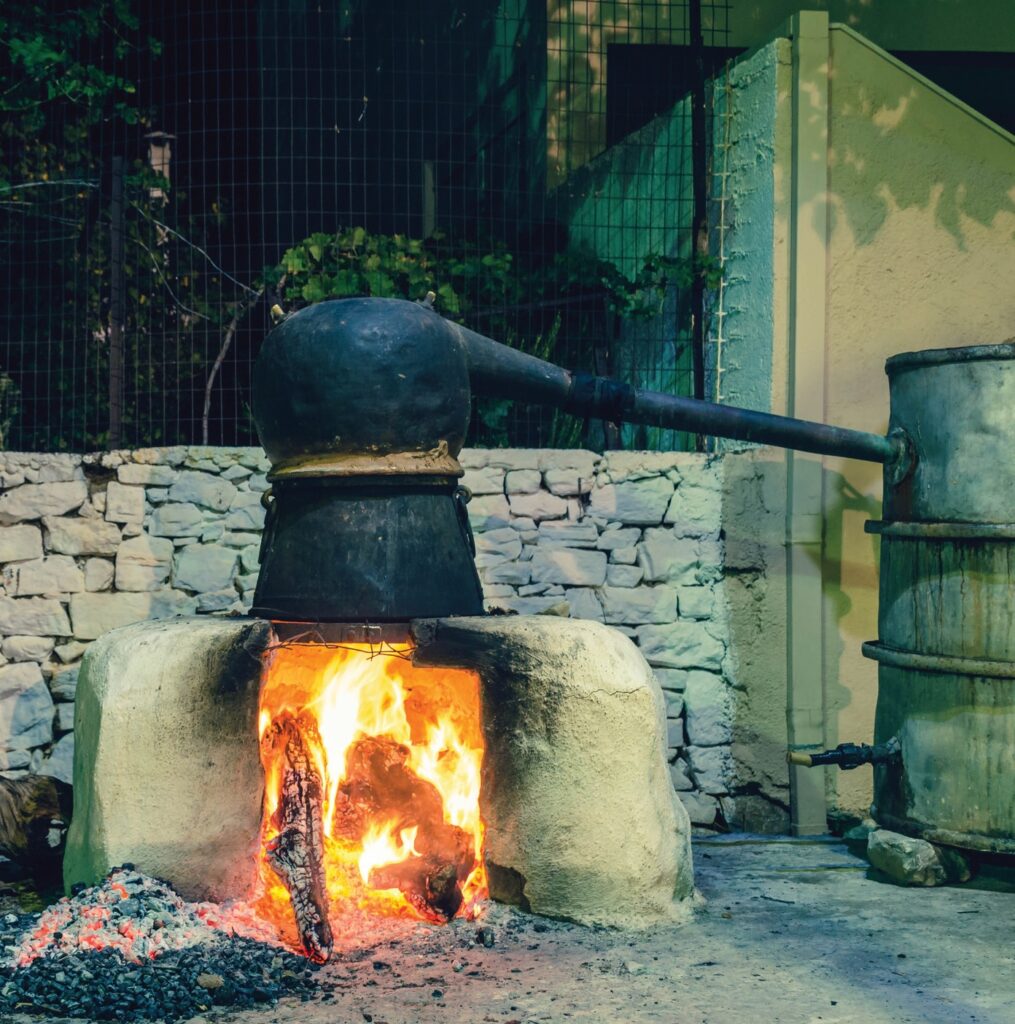From Traditional to Trendy
Posted by estiator at 22 December, at 11 : 58 AM Print

Tsipouro Comes Of Age
By Constantine N. Kolitsas
For many Greeks with families living on farms in the village, “smuggling” Tsipouro home in plastic containers that originally held things like Coca-Cola was a rite of passage. For rural communities throughout the country—but especially in the regions of Macedonia, Thessaly, and Crete (where it is known by the term “tsikoudia” on the western side of the island)—tsipouro was made by just about every household that produced wine. This makes sense, as the beverage is an after product of the winemaking process (skins, seeds, and leftover must from the grapes are distilled, very often in old copper kettles with con-denser coils and a collection vessel).
According to historians and industry insiders, the distillation of tsipouro dates back to the Hellenistic period of Ancient Greece, with monasteries on Mount Athos developing its current incarnation as far back as the days of the Byzantine Empire. Bottling the spirit was forbidden under the Ottomans, and until a 1988law lifted a long-standing prohibition on the commercial sale of tsipouro for direct consumption, the beverage was produced exclusively at home by amateur distillers—akin to moonshine for all intents and purposes. For years, the country’s commercial distillers lobbied to lift the ban and, since in 1988,as successive generations have continued to abandon the country’s small farms, production has steadily graduated from amateur home bulk production to spirits that are professionally distilled and bottled by some of Greece’s best spirits craftsmen.
Tsipouro (also known as “raki” in the Balkans as well as in some parts of Greece) is similar to other distillates made across the Mediterranean, from France (“marc”) to Lebanon (“arak”) and beyond, with Italy’s “grappa” being, perhaps, its most famous cousin. Before the commercial distillers began to produce a quality product, tsipouro was considered a beverage for old men, with harsh, over proof expressions being the norm.

Today, with dozens of labels lining the shelves of Greek liquor stores, amore refined tsipouro has claimed a place among younger drinkers, many of whom flock to drinkeries that specialize in the beverage (referred to as “tsipouradika”). Indeed, domestic sales are growing at a frantic clip, while domestic ouzo consumption is contracting. And with so many tourists visiting Greece, the demand for tsipouro is beginning to go global, with some of the best offerings now available in American and European markets. Fortunately for ouzo producers, demand abroad is strong, with Germans now consuming more ouzo than Greeks. In fact, in combination, more ouzo, tsipouro, and raki produced by Greek distilleries is being shipped abroad than ever before, with a historic record of exports exceeding pre-pandemic levels.
Heads and Tails
At a visit last May to the Costas Lazaridis winery, which has been making tsipouro alongside its flagship wines since its founding in the early 90s,I got a bird’s-eye view into how this traditional beverage is made by a modern commercial producer. Columns of distillation units line one of the rooms at the Lazaridis winery outside of Drama, an impressive sight that reminds one of an engine room on a naval frigate. Within each column, tsipouro is distilled four times in four distinct compartments. By the time it reaches the top of the column, it is pure steam, which is then condensed back into a fluid, resulting in a finished product that is smooth and delicious. The process begins as grape pomace, which is fermented, along with some of the juice (for example, the team at Costa Lazaridi only uses 60 percent of the pressing for their wines, leaving the remaining 40 percent for use in the production of tsipouro and its peripheral relation, apostagma). Temperature and pres-sure are monitored as the mixture is distilled, with the first and last batches(the “head and the “tail”) discarded, leaving the “heart” to be distilled for a second time.
The beverage was produced exclusively at home by amateur distillers—akin to moonshine for all intents and purposes.
The art of making great tsipouro is in knowing where the separation between the head and the heart lies, as well as the separation between the heart and the tail. According to Giorgos Zacharis of the Constantinos Lazaridis Winery-Bottling Company, while there are gauges and tools that he and most distillers use, for his company’s Idonikos raki(one of the biggest sellers in Greece), it’s the distiller’s nose that truly tells him when to make those separations. Being off just a little bit can ruin the entire batch, with dangerous methyl alcohol entering the mix. You’ve heard of people going blind from drinking moon-shine? It usually happens when someone drinks the head, or when an inexperienced distiller (home or professional) allows too much of the head into the final product. Not too long ago, the people of Turkey were in uproar over scores of deaths associated with people drinking “bad” raki. When this part of the process is complete, tsipouro usually has an ABV of about 85 percent, which is then diluted with water to approximately 40to 45 percent. In the amateur versions, that number can get much higher, resulting in a harsh, over-strong tsipouro. On the other end of the process, the tail can sometimes be harvested and redistilled.
Quality
The best tsipouros are made from good-quality grapes, and just as with a good wine blend, the taste of the final product is dependent on the variety of grapes used, soil composition, cultivation techniques, altitude of the vineyards, etc. Some distillers, Costas Lazaridis included, produce tsipouros from single varietals. In addition, they produce a very high-quality product known as apostagma, which, because it exceeds the amount of grape juice added to the pomace, cannot be marketed as tsipouro.
To blur the lines between tsipouro and ouzo, about 10 percent of the tsipouro marketed is infused with an herb known as glykaniso in Greek, or anise in English. Sound familiar? Yes, this is the same flavoring used in ouzo. So, then, you are wondering, what’s the difference between the two?
The European Union now recognizes tsipouro as a product that must be distilled in Greece from the pomace of grapes grown in Greece.
Where ouzo may have at one time begun as a grape distillate, it has since the 1920s shifted away from its grape origins. By law, ouzo is made from a rectified spirit of agricultural origin (with the exception of grapes), which means its base is most often from grain or corn. This first distillate is imported from abroad in bulk form. Ouzo producers in Greece purchase the distillate (most often from companies in Bulgaria) and then distill it again, adding the anise and any other aromatics (up to 14 are permitted by law) that are called for by their proprietary recipes. By contrast, a quality tsipouro producer will make tsipouro from grapes grown in its own vineyards.
As has happened with grappa in Italy, commercial production of tsipouro has brought about amore refined and more widely respected spirit. The European Union now recognizes tsipouro as a product that must be distilled in Greece from the pomace of grapes grown in Greece, with special geographic indications, namely Tsipouro of Macedonia, Tsipouro of Thessaly, and Tsipouro of Tyrnavos. These developments signal that tsipouro is not a novelty but a quality spirit that is finally reaching out behind its ancient, if humble, origins. Stin hygeia mas!














